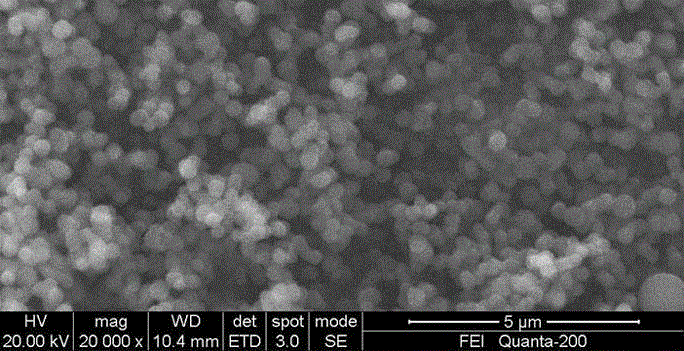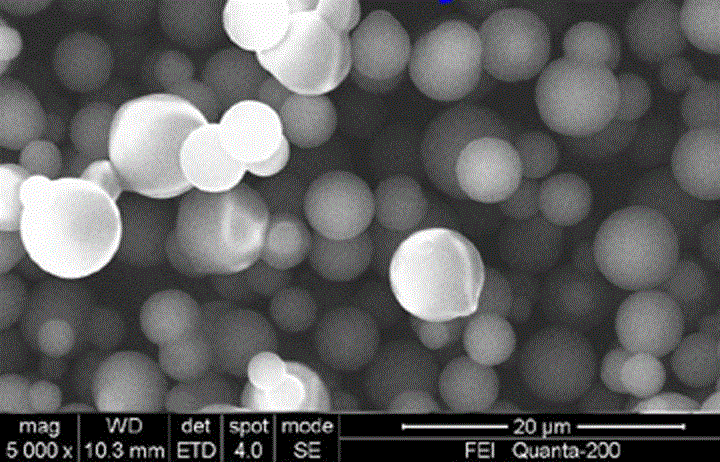Low temperature hydrothermal preparation method of biomass carbon microsphere / nanosphere
A biomass carbon, nanosphere technology, applied in nanotechnology, nanotechnology, nanotechnology for materials and surface science, etc., can solve problems such as unfavorable large-scale industrial production, unfavorable energy saving, safety issues, etc. The effect of rich oxygen-containing functional groups, high safety, and low hydrothermal carbonization temperature
- Summary
- Abstract
- Description
- Claims
- Application Information
AI Technical Summary
Problems solved by technology
Method used
Image
Examples
Embodiment 1
[0025] Example 1: Put 6 g of glucose into the polytetrafluoroethylene lining of a 100 mL reactor, weigh 0.9 g of urea and dissolve it in 60 mL of deionized water, then add it to the above polytetrafluoroethylene lining, stir with a glass rod to make it all Dissolve, then put into the stainless steel reaction kettle, tighten the reaction kettle, put it in the oven, set the reaction condition as: temperature 110 ° C, the reaction time is 12 h; after the reaction is finished, cool down to room temperature naturally, take out the polytetrafluoroethylene lining, separate it with a high-speed centrifuge, redisperse it with deionized water and 95% ethanol and wash it repeatedly until the supernatant is colorless, The resulting solid was dried to obtain 0.75 g of carbon nanospheres with a particle size of about 450 nm.
Embodiment 2
[0026] Example 2: Put 12 g of glucose into the polytetrafluoroethylene lining of a 100 mL reactor, weigh 5.27 ml of 25% ammonia water and dissolve it in 60 mL of deionized water, add it to the above polytetrafluoroethylene lining, and stir with a glass rod Make it all dissolve, then put it into a stainless steel reaction kettle, tighten the reaction kettle, put it in an oven, and set the reaction conditions as follows: temperature 130 ° C, the reaction time is 48 h; after the reaction is finished, cool down to room temperature naturally, take out the polytetrafluoroethylene lining, separate it with a high-speed centrifuge, redisperse it with deionized water and 95% ethanol and wash it repeatedly until the supernatant is colorless, The resulting solid was dried to obtain 3.55 g of carbon microspheres with a particle size of about 3 μm.
Embodiment 3
[0027] Example 3: Put 3 g of glucose into the polytetrafluoroethylene lining of a 100 mL reactor, weigh 0.09 g KOH and dissolve it in 60 mL of deionized water, then add it to the above polytetrafluoroethylene lining, and stir it with a glass rod to make it all Dissolve, then put it into a stainless steel reaction kettle, tighten the reaction kettle, put it in an oven, set the reaction conditions as follows: temperature 120 °C, the reaction time is 72 h; after the reaction is finished, cool down to room temperature naturally, take out the polytetrafluoroethylene lining, separate it with a high-speed centrifuge, redisperse it with deionized water and 95% ethanol and wash it repeatedly until the supernatant is colorless, The resulting solid was dried to obtain 0.85 g of carbon nanospheres with a particle size of about 300 nm.
PUM
| Property | Measurement | Unit |
|---|---|---|
| particle diameter | aaaaa | aaaaa |
| particle diameter | aaaaa | aaaaa |
| particle diameter | aaaaa | aaaaa |
Abstract
Description
Claims
Application Information
 Login to View More
Login to View More - Generate Ideas
- Intellectual Property
- Life Sciences
- Materials
- Tech Scout
- Unparalleled Data Quality
- Higher Quality Content
- 60% Fewer Hallucinations
Browse by: Latest US Patents, China's latest patents, Technical Efficacy Thesaurus, Application Domain, Technology Topic, Popular Technical Reports.
© 2025 PatSnap. All rights reserved.Legal|Privacy policy|Modern Slavery Act Transparency Statement|Sitemap|About US| Contact US: help@patsnap.com


